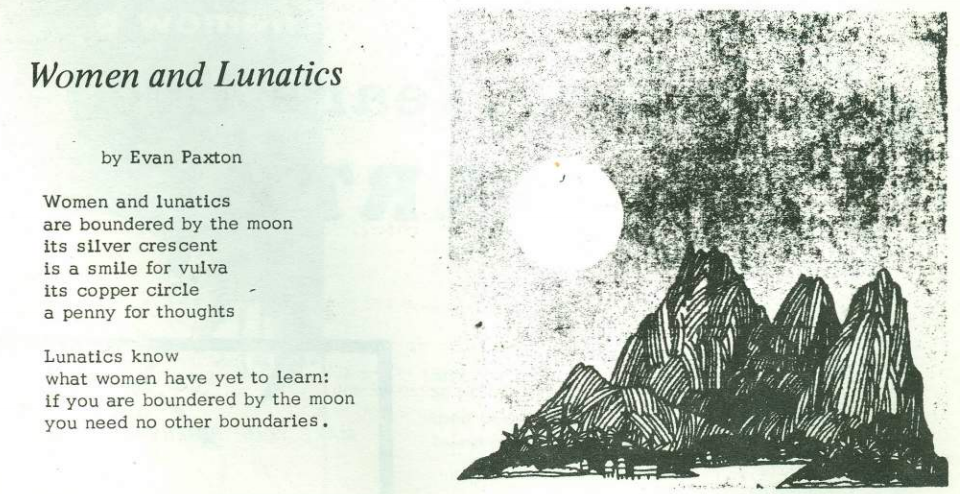MOON
The moon was a permanent fixture of women’s print in the seventies. Often an object of meditation in poetry, or revered in art work, the moon symbolically shepherded emotional journeys through the trauma of lost love or closeted relationships. And when it was full, it often illuminated radical activity and emotional events.
Practitioners of various spiritual practices ritualized the moon’s phases and studied its patterns. A divine yet common thread, the moon was fundamental to worshipers and their beliefs. Its centrality in Queer art paralleled the revival of Paganism, a nature-based religion that often emphasizes cycles of lunation or solstice. Womanspirit, a publication dedicated exclusively to lesbian feminism and Spirituality, even organized its issues around solstices, equinoxes, and the phases of the moon.
Above and below: Stella Stardust and Her Devoted Assistant, “Celestial Happenings,” DYKE, Vol. 1, Iss. 1, Winter 1975 - 1976
In her column “Celestial Happenings,” Stella Stardust wrote of lunation cycles and the moon’s meanings, from representations in Judaism on Yom Kippur to the “traditional witch’s night” when the waxing gibbous is at its fullest. Farming, matriarchal cultures, and the moon’s waxing and waning are referenced in connection to its cycles.
“In Astrology we believe that the lunar cycle is a guide to the present and can offer real insight into what is happening in your life.”
Unknown Creator, “Untitled,” Blazing Star, Vol. 5, Iss. 5, September 1979
Chicago’s Blazing Star published the above artwork to accompany the article “The New Alexandria Library: Her-story.” According to the article, the New Alexandria Lesbian Library (NALL) took its name from “the Great Library at Alexandria, Egypt,” a repository of ancient wisdom prior to its destruction.
“The concept and the reality of a lesbian library is revolutionary,” the article reads. “It means we have taken the courage to […] pass on to our daughters and granddaughters the continuum and interconnectedness of our lesbian lives.”
In 1992 NALL was renamed the Sexual Minorities Archives (SMA) by curator Ben Power Alwin to reflect their expansive collecting. SMA holds a collection of NALL papers: the finding aid shows that at one point, possibly in the '80s, “Wimin’s Spirituality” was added to the library's classifications list. SMA in turn includes subject files on "Lesbians and Witches" as well as Lesbian, Bi, Trans and Gay Spirituality.
Evan Paxton, “Women and Lunatics" The Lesbian Tide, December 1972
Poetry was an empowering force in the early years of feminist print. Lesbian and feminist writers used it as a vehicle through which they could illustrate the complexities of their individual experiences publicly, and some for the first time. Words of movement leaders and everyday grassroots members existed alongside one another, speaking to the joys and pains of Queer life. An enduring tool of the Women in Print Movement, poetry was used across lines of race, class, and position.
Above and below: Moon, “In Order of a Name Change," DYKE, Iss. 3, Fall 1976
“My decision to be Moon was based on the following premises: I wanted a word of nature for my name, because I feel nature as a female force; I appreciated ‘mythological’ relationship to Diana Artemis, to the moon; I wanted to be stronger with the night, an element I have always been fearful of, and felt more serene to know the moon is there, continuous and rock solid; and I felt a comfort in the relationship of the moon to menses and menstruation, to the tides, and to Cancer, my astrological moon sign.”
Enid Dame, “The Moon is No Muse,” Conditions, Vol. I., Iss. I, April 1977
[Emily?] Oddwoman, Untitled, Blazing Star, Vol. 5, Iss. 5, September 1979
The labrys, carried by the Mother Goddess of the ancient Minoan Civilization that flourished in the Aegean world until 1450 B.C., was a double-sided battle axe claimed by lesbian feminists in the early seventies.
Labrys was the first of the feminist bookstores that opened in New York City: lesbian-owned, it existed as a critical movement space for lesbian feminists. Though an attempt to save the store was made by bringing poets Audre Lorde and Robin Morgan in for a fundraiser, Labrys closed its doors in 1977 after operating for five years.
Kaymarion Raymond, “The Ballad of the Lonely Masturbator,” Amazon Quarterly, Vol. II Iss. II, December 1973








![[Emily?] Oddwoman, Untitled, Blazing Star, Vol. 5, Iss. 5, September 1979](https://images.squarespace-cdn.com/content/v1/60441252513f6b5c4dcadddc/1620848728118-UJ29IL008RR25GUSPTX4/Screen+Shot+2021-05-12+at+3.44.52+PM.png)
